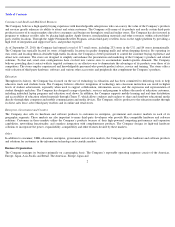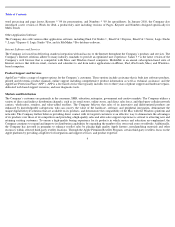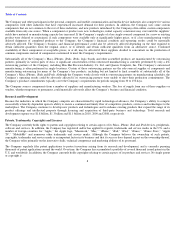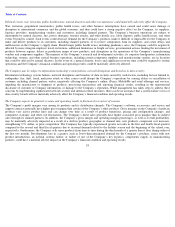Apple 2010 Annual Report Download - page 15
Download and view the complete annual report
Please find page 15 of the 2010 Apple annual report below. You can navigate through the pages in the report by either clicking on the pages listed below, or by using the keyword search tool below to find specific information within the annual report.
Table of Contents
design advantages. Use of unauthorized copies of the Mac OS on other companies’
hardware products may result in decreased demand for the
Company’s hardware products, and could materially adversely affect the Company’s financial condition and operating results.
The Company currently markets certain mobile communication and media devices, and third-
party digital content and applications. The
Company faces substantial competition from companies that have significant technical, marketing, distribution and other resources, as well as
established hardware, software and digital content supplier relationships. Additionally, the Company faces significant price competition as
competitors reduce their selling prices and attempt to imitate the Company’
s product features and applications within their own products or,
alternatively, collaborate with each other to offer solutions that are more competitive than those they currently offer. The Company also
competes with illegitimate ways to obtain third-
party digital content and applications. The Company has only recently entered the mobile
communications and media device markets, and many of its competitors in these markets have significantly greater experience, product
breadth
and distribution channels than the Company. Because some current and potential competitors have substantial resources and/or experience and a
lower cost structure, they may be able to provide such products and services at little or no profit or even at a loss. The Company also expects
competition to intensify as competitors attempt to imitate the Company’
s approach to providing these components seamlessly within their
individual offerings or work collaboratively to offer integrated solutions.
The Company currently receives subsidies from its exclusive and non-
exclusive carriers providing cellular network service for iPhone. There is
no assurance that such subsidies will be continued at all or in the same amounts upon renewal of the Company’
s agreements with these carriers
or in agreements the Company enters into with new carriers.
There can be no assurance the Company will be able to continue to provide products and services that compete effectively.
To remain competitive and stimulate customer demand, the Company must successfully manage frequent product introductions and transitions.
Due to the highly volatile and competitive nature of the industries in which the Company competes, the Company must continually introduce
new products, services and technologies, enhance existing products and services, and effectively stimulate customer demand for new and
upgraded products. The success of new product introductions depends on a number of factors including but not limited to timely and successful
product development, market acceptance, the Company’
s ability to manage the risks associated with new products and production ramp issues,
the availability of application software for new products, the effective management of purchase commitments and inventory levels in line with
anticipated product demand, the availability of products in appropriate quantities and costs to meet anticipated demand, and the risk that new
products may have quality or other defects in the early stages of introduction. Accordingly, the Company cannot determine in advance the
ultimate effect of new product introductions and transitions on its financial condition and operating results.
The Company faces substantial inventory and other asset risk in addition to purchase commitment cancellation risk.
The Company records a write-
down for product and component inventories that have become obsolete or exceed anticipated demand or net
realizable value and accrues necessary cancellation fee reserves for orders of excess products and components. The Company also reviews its
long-
lived assets for impairment whenever events or changed circumstances indicate the carrying amount of an asset may not be recoverable. If
the Company determines that impairment has occurred, it records a write-
down equal to the amount by which the carrying value of the assets
exceeds its fair market value. Although the Company believes its provisions related to inventory, other assets and purchase commitments are
currently adequate, no assurance can be given that the Company will not incur additional related charges given the rapid and unpredictable pace
of product obsolescence in the industries in which the Company competes. Such charges could materially adversely affect the Company’
s
financial condition and operating results.
12
























